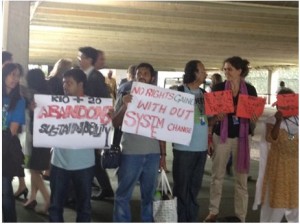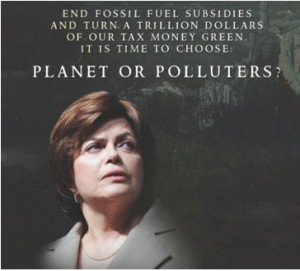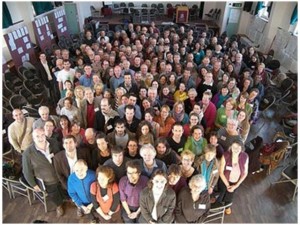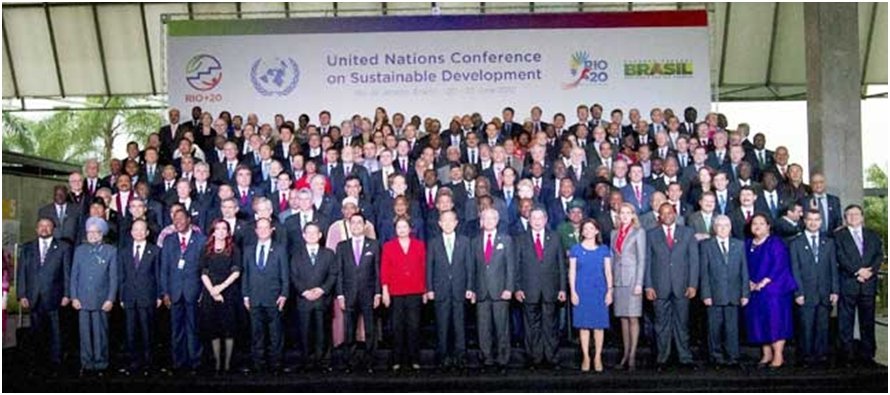Río+20: the future we want?
‘The Future We Want’ –the main result from Rio+20— has generated disappointment in many people for it seems to be proposing the opposite of what the title suggests. This work first analyzes some partial positive and negative aspects of the document, and then explains the rationale for this disappointment from an economic perspective: the 16 references that document makes to ‘sustained economic growth’ as a necessity for sustainable development. The conclusion is that not much can be expected from large deals between worldwide governments. Local communities –the real leaders in the way to sustainable development— can hardly expect the support from such treaties. Governments, on their side, will remain using the same recipes to solve the problems that those recipes have caused.
Remarkable aspects in ‘The Future We Want’
Part of the good points and disappointments in the Rio +20 Declaration ‘The Future We Want’ below are gathered from Stakeholder Forum’s Farooq Ullah.
There are some good points (remarkably the first two below):
– It strengthens and enhances the position of UNEP within the UN organization, establishing universal participation in it and providing it with more funds.
– It opens a process for establishing a set of Sustainable Development Goals to replace the Millennium Development Goals when they expire –with many failures— by 2015.
-A paragraph in the Declaration “encourage(s) companies, where appropriate, especially publicly listed and large companies, to consider integrating sustainability information into their reporting cycle”.
– It confirms the will to eliminate subsidies that contribute to illegal, unreported, and unregulated fishing, wasteful consumption or inefficiencies in international trade.
There are also come disappointments:
– The language on the right to water and sanitation is vague and evasive. The text reaffirms commitments which are not universally agreed, rather than affirming the right itself.
– The right to reproductive health was removed due to the pressure from some lobbies – namely the Vatican.
 – It is very worrying that, despite 20 years of talking about it, there is no action plan for eliminating environmental harmful subsidies to fossil fuels. The amount spent on these subsidies would go a long way to providing the financing for the transition to a sustainable world. In fact, the means of implementation remain weak.
– It is very worrying that, despite 20 years of talking about it, there is no action plan for eliminating environmental harmful subsidies to fossil fuels. The amount spent on these subsidies would go a long way to providing the financing for the transition to a sustainable world. In fact, the means of implementation remain weak.
– There is no clear statement on the need to remain within environmental limits, thereby defining new pathways to sustainable development.
– The paragraphs regarding a ‘green economy in the context of sustainable development and poverty eradication’ do not give a definition of it, and give a set of low profile guidelines on the characteristics that it should have. All actions are left to the will of the nation states, thus spoiling any approach to a sovereignty cession from countries to a supranational authority in global, common environmental regards.
The big fiasco
 The key point that might gather all the strong disappointment from civil society to ‘The Future We Want’ are the 16 calls that it makes to ‘sustained economic growth’, plus 4 others to ‘economic growth’, as a neeed for sustainability, without conditioning it to its feasibility. Any free-thinking economist knows that a sustained economic growth requires conditions that do not occur in the current economy.
The key point that might gather all the strong disappointment from civil society to ‘The Future We Want’ are the 16 calls that it makes to ‘sustained economic growth’, plus 4 others to ‘economic growth’, as a neeed for sustainability, without conditioning it to its feasibility. Any free-thinking economist knows that a sustained economic growth requires conditions that do not occur in the current economy.
The failure of the economy lies in the very first lesson of Economics: it is a science born to solve the problem of resource scarcity. Given that the economy is not yet (and will probably not ever be) able to internalize the environmental scarcity –which did not even partially seek to until the Kyoto Protocol, and then failed dramatically— and not being labor a scarce resource –on the contrary, scarce is precisely its counterpart: the employment—, the economy is at the service of the two other group of resources considered by traditional Economics: capital and land; and, among these, evidences like speculation on real estate or the purchase of massive African territory by China make clear which predominates. When a part of a system fails, it fails as a whole, and therefore the economy (particularly the neoliberal) does not serve to its purpose: the allocation of resources; not to say optimum, but even tolerable by the overall system it belongs to: the biosphere. The return of capital are the interests and these need borrowing, which in turn requires an economic growth big enough to guarantee that in the future we will pay for what we will then spend plus for what we now cannot pay. The problem is that, in that future, the capital will continue to need borrowing, and therefore more growth. Continued growth is not viable in a world with limited resources that the economy does not consider. The higher the growth, the more it will be at the expense of those resources that are not considered: the environment and the labor. On the first, by failing to amortize the basis of physical resources that production wears off, economic growth consumes it until its destruction. And on employment, unless a legislation as unlikely to happen as a substantial reduction of working hours available makes labor scarce again, growth will be at the expense of the total wage bill – in other words it will create more unemployment, lower wages or any combination of both. This very basic reflection based on the economic theory makes clear that sustained economic growth is not only impracticable, but, given the current (im)balance of resources, it is aimed at the service to the capital, to the detriment of those resources that the economy does not consider: environment and labor. Only the capital who needs growth; neither the labor of the environment need it.
The Brundtland report in 1987 not only gave the most widely accepted definition of sustainable development (SD) as a “development which meets the needs of the present without compromising the ability of future generations to meet their own needs”, but in the second chapter, it devoted over 20 pages to clarify the concept. Besides other interesting notes, now relevant is the paragraph that reads: “(…) sustainable development clearly requires economic growth in places where such needs are not being met. Elsewhere, it can be consistent with economic growth, provided the content of growth reflects the broad principles of sustainability and non-exploitation of others.” Economic growth is therefore not imperative in developed countries, where basic needs are usually met. The report suggests that a minimum of economic growth, as required by financial institutions, can be environmentally sustainable only if industrialized nations shift their growth towards less material and energy intensive activities.
There are two arguments that might make economic growth compatible with sustainable development in rich countries: the dematerialization of growth and technological progress. But, as I will explain, both are too weak to be relied upon.
Daly and Townsend explain how that dematerialization is indeed an unattainable concept, since growth that aims to satisfy the needs of the poor should be based on things they need, which are not precisely information services but material things like food, clothing and shelter. To make room for the pollution and resource use that the manufacturing of these products for poor countries generates, it is clear that rich countries must reduce their pollution at least equivalently. This is a strong conditioning to rich countries’ economic growth, for the reasons that follow. If economic growth was not based on resource use, there would be no problem. Some environmental stakeholders (remarkably the World Bank) have long defended in past decades the existence of an Environmental Kuznets Curve that, in the long term, would revert the link between economic growth and environmental degradation through a dematerialization of the economy; but this theory has long been refuted by theory and experience. Numerous calls have been made to the decoupling of the economy from resource use, but resources remain being borrowed from the future at an increasing rate. It is essential to distinguish between relative and absolute decoupling. There are thousands of cases of decreased intensity in resource use per output unit (relative decoupling), but the increases in the scale of global economic activity cancel these improvements. Jackson estimates that, in order to stabilize the climate in a world with 9 billion habitants with revenues as the EU average in 2008, relative decoupling should occur at a rate 16 times higher than that which has occurred so far.
As for the argument that the technology could save us from climate change, the IPAT identity proves the high infeasibility of this argument, when not only the technology, but also increases in population and affluence (purchasing power) are taken into account. The implications of this theory entail that, in order to achieve a CO2 concentration of 450 ppm (which many consider to be very harmful) by 2050, with economic growth of 2-3% in the developed world and in 5-10% developing countries, required energy efficiency improvements should occur at a rate 11 times higher than currently.
 The discourse on the dematerialization of growth or technological progress as ways to make economic growth compatible with sustainable development has proven too weak to be relied upon for overcoming the essential failure of the economy. As Chandran Nair states, “policymakers must concede that economic growth has met its nemesis in climate change, and they should not be seduced by the market’s quick fixes.”
The discourse on the dematerialization of growth or technological progress as ways to make economic growth compatible with sustainable development has proven too weak to be relied upon for overcoming the essential failure of the economy. As Chandran Nair states, “policymakers must concede that economic growth has met its nemesis in climate change, and they should not be seduced by the market’s quick fixes.”
When K. Boulding said that “anyone who believes that exponential growth can go on forever in a finite world is either a madman or an economist”, he was clearly referring only to myopic economists, because those who claimed against the paradigm of economic growth have been many. H.E. Daly (1977) proposed to replace the ‘more is better’ by the much wiser axiom of ‘enough is the best’. Much earlier, J.K. Galbraith (1956) warned that our concern for growth in the number of goods produced, the growth rate of GNP, will –better sooner than later— have to give way to the more important quality of life they provide. J.S. Mill (1848) stated one century before the evidence that the increase of wealth cannot be unlimited. E.F. Schumacher (1989) certifies that a lifestyle that is based on unlimited growth can not last long. Jackson reflects the great challenge of our times: economic growth is necessary for our wrong economy not to collapse, in a world that cannot support that growth without collapsing, for reasons both environmental and social, as follows from some paragraphs above. Jackson concludes that economic growth is not only not the solution to the crisis, but precisely the underlying cause of it. Similar conclusions can be drawn from Azkarraga et al., who explain the reasons of our current global problems analyzing different aspects including the system crisis of values, social and population, and providing with valuable references. Even J.M. Keynes (1935), whose proposals for expansion of public expenditure have been identified as a good part of the cause of the current crisis, called to consider values more important than wealth. He said that the challenge for change does not lie as much in new ideas as in escaping from the old ones, which have grown with us invading every corner of our minds, and railed against orthodox economists whose logic led to the disastrous Great Depression –in a way that shares with the logic which has led to the current crisis the spiral of speculation; with the peculiarity that the ideas that the world now needs to escape from are precisely the ones that his school proposed, that have led to a governments-led speculation.
We are, therefore, watching a case that perfectly matches what Einstein stated: “We can’t solve problems by using the same kind of thinking we used when we created them.” Economic growth, as Bass confirmed, “is viewed more as an inviolable principle that as a solution for the rights of individuals, welfare or environmental degradation.”
Conclusion
Following all the above, The Future We Want might be committing a deep mistake when it says “We also recognize the need to (…) seize and create opportunities to achieve sustainable development through economic growth and diversification, social development and environment protection.” , among other 19 explicit references that the document makes to economic growth, 16 of which specify that it must be sustained; not ‘sustainable’, which would at least be a key conditioning, but ‘sustained’: a real oxymoron. Ban Ki Moon’s statement in 2009 gains sense: “Our foot is stuck on the accelerator and we are heading towards an abyss”.
Since poor countries need economic growth to overcome poverty and the rich do not renounce to economic growth, the prospects of a world driven by these political arrangements are bleak. Being the delivery of a decent world to following generations a categorical imperative (one objective to be pursued without conditions), the reins of development cannot be left to the government leaders who seem not to be able to withstand the pressures from the most economically powerful.
Alternatives
The debate about the green economy is being held around its guiding principles. Stakeholder Forum identifies fifteen of them: equitable distribution of wealth; economic equity and fairness; intergenerational equity; precautionary approach; right to development; internalization of externalities; international cooperation; international liability; information, participation and accountability; sustainable consumption and production; strategic, co-ordinated and integrated planning; just transition; redefinition of well-being; gender equality; and safeguard of biodiversity and pollution prevention.
 Arguably, these principles can be seen as the social and environmental profiles required in the economy. If the economy was able to internalize the positive and negative, environmental and social externalities above listed, then seeking profits would automatically carry not only financial, but also social and environmental returns. Is it any likely in this decade? Not really.
Arguably, these principles can be seen as the social and environmental profiles required in the economy. If the economy was able to internalize the positive and negative, environmental and social externalities above listed, then seeking profits would automatically carry not only financial, but also social and environmental returns. Is it any likely in this decade? Not really.
While this does not happen, those principles might only be applied to social business. Following Prof. Yunus, a social business is “a non-loss, non-dividend company created to address and solve a social problem”. EU’s Social Business Initiative definition of social businesses social business accords to Yunus’, but it seems to restrict its application to vulnerable and disadvantaged groups, when a social business has the potential to positively affect to the entire social group. In a time when the EU is losing position in global markets, precisely due in part to a lack of internalization of externalities, a repositioning of the EU beyond financial returns might provide it with the first mover’s advantage in the trend to a new, integrative, green economy, without the need for global governance agreements; and so contribute to implementing an imperatively needed global change toward a re-localization of the economies.
 The Transition Towns, Post Carbon Cities, Slow Cities or Swedish Ecomunicipalities movements, among many others that remain non-associated, might be the dawn of a generation of social businesses initiated by responsible citizens that embrace alternative ways of development, empowered through their living communities and fuelled by motivations of responsibility, justice, or food, energy, water or climate security rather than by institutional support. These socially innovative initiatives are proposing a different way of thinking in order to solve the problems caused by prevailing paradigms of obsessive economic growth, cheap energy, wealth accumulation and individualism.
The Transition Towns, Post Carbon Cities, Slow Cities or Swedish Ecomunicipalities movements, among many others that remain non-associated, might be the dawn of a generation of social businesses initiated by responsible citizens that embrace alternative ways of development, empowered through their living communities and fuelled by motivations of responsibility, justice, or food, energy, water or climate security rather than by institutional support. These socially innovative initiatives are proposing a different way of thinking in order to solve the problems caused by prevailing paradigms of obsessive economic growth, cheap energy, wealth accumulation and individualism.
They rely on the assets that exist within communities, reorienting them to resilience-building and to serve the common well-being, while meeting the basic principles of sustainable development. They are happening worldwide through bottom-up driving forces, but they still need to be promoted with top-down incentives if they are to be globally adopted. These incentives should not only spread the voice for the case but also, critically, focus on building the economic viability of community approaches that are socially and environmentally desirable –thus completing, and fundamentally rebalancing, the three pillars of sustainability.
Peter Senge, a guru of organizational design, states it clearly: “If there is any hope for us it lies in rediscovering and recreating community – bringing forth our DNA as social animals into today’s world.” The needed innovation, rather than technological, is social; or, more properly said, systemic.
A reading of some well-intentioned pre-Rio documents (‘Resilient People, Resilient Planet (…)’, the original Draft Zero and Lalonde’s Coordination Notes) with this vision in mind, shows how far they share it. Unfortunately, the well-intentioned vision of these documents has been unable to stand with the power of those who rule the world with visions that are so myopic as the one of the economists referred by Boulding. It is the fatal tragedy of the commons.
Alejo Etchart
Independent Advisor to Stakeholder Forum
